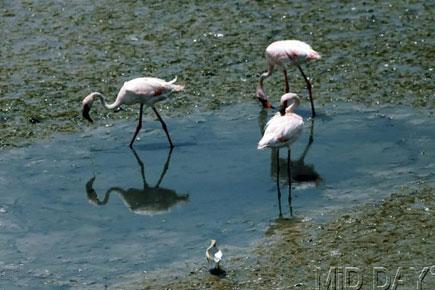According to activists and bird lovers, the wetlands around Jawaharlal Nehru Port Trust’s customs house and Uran are drying up as the area is being used for commercial purposes, making it unsuitable for birds

Nature lovers and residents of areas around the Jawaharlal Nehru Port Trust (JNPT) are concerned about the alarming rate at which the wetlands surrounding the port premises are drying up. In the last few months, the area around JNPT customs house has been filled with debris, making the place unsuitable for migratory birds to make a stopover in the city during winters.

mid-day found debris around tthe wetlands near JNPT’s customs house, which is shrinking the area used by birds
ADVERTISEMENT
Several migratory birds such as Flamingos, Herons, Bronze-headed Jacanas, Ibises, Spoonbills, Storks as well as ducks, resident birds like Kites, Kingfishers, Shikras and Koels are a treat for bird lovers in the season. However, major open wetland spaces have been filled with mud and flattened for commercial purposes. One can see dumpers throwing debris on wetlands and small ponds around the customs house.

This has also been done near Jasai for a speedy container freight station. “Wetlands around Uran and JNPT are a wintering and breeding place for many birds, including several critically endangered, vulnerable and near-threatened species. The wetlands are an important stopover for passage migrant birds that came in from as far as Europe, Central Asia and the Arctic Tundra.
But the number of birds has reduced from thousands to mere hundreds as, in the last few months, the area of around 10-12 sq km has been filled up,” Manoj Das, a bird lover and Superintendent at JNPT customs house said. “Earlier, over 10,000-12,000 flamingos could be observed around JNPT and Uran. However, rapid filling of wetlands has reduced their numbers. In addition, the channels through which wetlands used to get water are also being filled,” he added.
Das said that many species of birds, including Herons, Flamingoes and Rudy Shelducks, that have the International Union for Conservation of Nature (IUCN) Red Data status also visited JNPT and its neighbouring areas. Several of these species also fall under Schedule I and IV of the Wildlife Protection Act, 1972.
Locals staying around JNPT have also been concerned about the number of migratory birds reducing marginally. Sandeep Bangia, a member of Navi Mumbai Environment Preservation Society (NMEPS), said, “We are saddened by the loss of habitat due to unauthorised filling of wetlands.
It has increased rapidly in the area in the last six months. Our society has also filed a PIL highlighting the alarming rate at which debris is being dumped across various eco-sensitive stretches of Navi Mumbai.” Activists allege that rather than utilising the open ground next to the customs building, they are filling up the wetlands for commercial purposes.
 Subscribe today by clicking the link and stay updated with the latest news!" Click here!
Subscribe today by clicking the link and stay updated with the latest news!" Click here!







